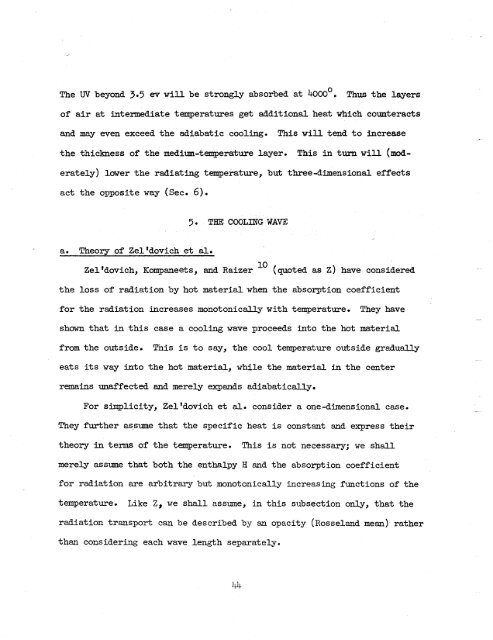Theory of the Fireball
Theory of the Fireball
Theory of the Fireball
Create successful ePaper yourself
Turn your PDF publications into a flip-book with our unique Google optimized e-Paper software.
The W beyond 3.5 ev will be strongly absorbed at 4 0'. Thus <strong>the</strong> layers<br />
<strong>of</strong> air at intermediate temperatures get additional heat which counteracts<br />
and may even exceed <strong>the</strong> adiabatic cooling. This will tend to increase<br />
<strong>the</strong> thickness <strong>of</strong> <strong>the</strong> medium-temperature layer. This in turn will (mod-<br />
erately) lower <strong>the</strong> radiating temperature, but three-dimensional effects<br />
act <strong>the</strong> opposite way (Sec. 6) .<br />
a . <strong>Theory</strong> <strong>of</strong> Zel 'dovich et al.<br />
Zelsdovich, Kompaneets, and Raizer lo (quoted as Z) have considered<br />
<strong>the</strong> loss <strong>of</strong> radiation by hot material when <strong>the</strong> absorption coefficient<br />
for <strong>the</strong> radiation increases monotonically with temperature. They have<br />
shown that in this case a cooling wave proceeds into <strong>the</strong> hot material<br />
from <strong>the</strong> outside. Tnis is to say, <strong>the</strong> cool temperature outside gradually<br />
eats its way into <strong>the</strong> hot material, while <strong>the</strong> material in <strong>the</strong> center<br />
remains unaffected and merely expands adiabatically.<br />
For simplicity, ZelPdovich et al. consider a one-dimensional case.<br />
They fur<strong>the</strong>r as,sume that <strong>the</strong> specific heat is constant and express <strong>the</strong>ir<br />
<strong>the</strong>ory in terms <strong>of</strong> <strong>the</strong> temperature. This is not necessary; we shall<br />
merely assume that both <strong>the</strong> enthalpy H and <strong>the</strong> absorption coefficient<br />
for radiation are arbitrary but monotonically increasing functions <strong>of</strong> <strong>the</strong><br />
temperature. Like 2, we shall assume, in this subsection only, that <strong>the</strong><br />
radiation transport can be described by an opacity (Rosseland mean) ra<strong>the</strong>r<br />
than considering each wave length separately.<br />
44
















